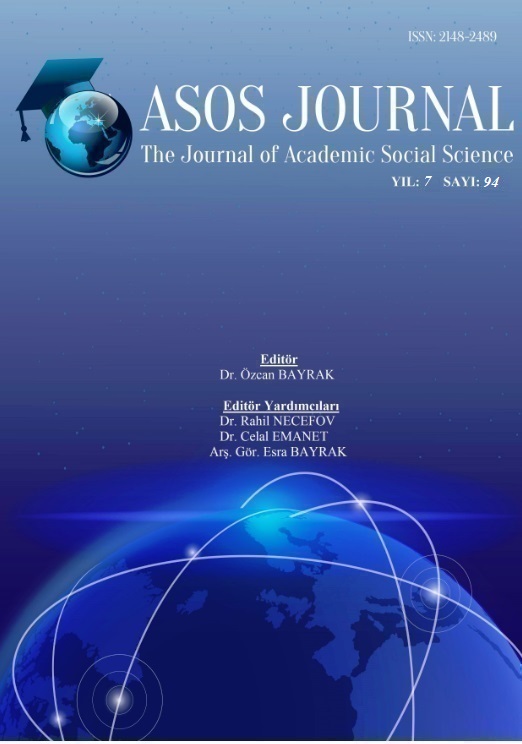Author :
Abstract
Batı klasik müzik etkinliklerindeki görgü kuralları içinde söz edilen alkışlama kuralına odaklanarak yapılan onlarca etkinlik gözlemi, çoksesli korolarda korist üye olarak katılımcı gözlem ve bu müzikle ilgili elli kişiyle görüşmeler yoluyla toplanan veriler bu makaleyi şekillendirdi. Bu nitel çalışma alkışlama kuralına uyulmamasının Batı klasik müzik camiası tarafından nasıl algılandığını, kurala uymayan izleyiciler hakkındaki yargıların neler olduğunu, beklenmedik zamanlarda gelen alkışa gösterilen tepkiyi ve bunların nedenlerini anlamaya yönelik yapıldı. Hem alan çalışması yöntem ve teknikleri kullanılarak hem de literatür taramasıyla toplanan görgü kuralları belli bir düzen içinde maddelenerek listelendi. Bu maddelerin bazılarının yalnızca etkinliklerde değil aynı zamanda toplumsal yaşamda da uygulanmasının doğru olacağını düşünürken alkışlama kuralı gibi bazı maddelerdeki görgü kurallarının ise abartılmaması gerektiğini düşünmekteyim.
Keywords
Abstract
The data gathered through dozens of activity observations focusing on the clapping rule mentioned in the etiquette of Western classical music activities, participatory observation as a chorist member in polyphonic choirs and the data collected through interviews with fifty people about this music have shaped this article. This qualitative study was carried out to understand how the non-compliance with the rule of applause was perceived by the Western classical music scene, the judgments about the audience who did not abide by the rule, the reactions to the untimely applause and the reasons for the applause. Both the field study methods and techniques, as well as the classical concert etiquette collected by literature review, were listed in a certain order. While I think that some of these items should be applied not only in activities but also in social life, I think that the etiquette in some articles such as clapping rule should not be exaggerated.
Keywords
- Adorno, T. W. (2012). Kültür Endüstrisi Kültür Yönetimi. (Çev. N. Ülner, M. Tüzel, & E. Gen) İstanbul: İletişim Yayınevi.
- Armağan, S., & Armağan, İ. (1988). Toplumbilim. İzmir: Barış Yayınları.
- Ax, E. (2008, November 14). When to Applaud. (WordPress.com weblog) Retrieved 03 10, 2019, from Emanuel Ax's Official Blog: https://emanuelax.wordpress.com/2008/11/14/when-to-applaud/
- Bali, S. (2010, 10 26). Müziği özgür bırakın. Retrieved 04 08, 2018, from Radikal Web Sitesi: http://www.radikal.com.tr/yazarlar/serhan-bali/muzigi-ozgur-birakin-1025554/
- Finkelstein, S. (2000). Müzik Neyi anlatır (3. Baskı ed.). (Çev. M. H. Spatar) İstanbul: Kaynak Yay.
- Griffiths, P. (2010). Batı Müziğinin Kısa Tarihi. (Çev. M. H. Spatar.) İstanbul: Türkiye İş Bankası Kültür Yayınları.
- Hançerlioğlu, O. (1992). Türk Dili Sözlüğü "Görgü, görgü kuralları". İstanbul: Remzi Kitapevi.
- Johnson, J. H. (1995). Listening In Paris: A Cultural History. Bekeles, CA: University Of California Press.
- Kan, S. (2013, 01 10). Alkış klasik müziğe zararlı mı? (M. D. Servisi, Interviewer) Milliyet.com.tr.
- Karşıcı, G. (2014). Müzik Beğenisinde Kültürel Etkenler: Bir fMRI Çalışması. Ankara: Gece Kitaplığı.
- Marcus, K. H. (2009, March). Creating a Musical Community The Founding of the Hollywood Bow. Journal of the West , vol.48 (2), pp. 68-75.
- O'Hagan, S. (2013, January 9). Why clapping ruins concerts. Retrieved Kasım 4, 2016, from The Independent Gazetesi Web Sitesi: http://www.independent.co.uk/artsentertainment/classical/features/why-clapping-ruins-concerts-8443218.html
- Oskay, Ü. (2001). Müzik ve Yabancılaşma: Aristo, Huizinga ve Adorno Açısından Bir Ön Çalışma (3. Baskı ed.). İstanbul: Der Yayınları.
- Örnek, F. (1967). Hava Kuvvetlerinde Muaşeret. Ankara: Hava Kuvvetleri Basımevi Etimesgut.
- Smith, C. P. (1993, Summer). Founding the Hollywood. American Music , Vol.11 (2), pp. pp. 206-242.
- Smith, T. (2002). The NPR Curious Listener's Guide To Classical Music. New York: The Berkley Publishing Group, A Grand Central Press Book.
- Üçöz, E. (2012, 12 16). Alkışlamak mı, alkışlamamak mı? Retrieved 04 07, 2019, from Andante Türkiye'nin Klasik Müzik Dergisi Web Sitesi: https://www.andante.com.tr/tr/3656/Alkislamak-Mi-Alkislamamak-Mi
- Wagener, A. (2012). Why Do People (Not) Cough In Concerts? The Economics Of Concert Etiquette. Association for Cultural Economics International, ACEI Working Paper Series (5), 1-29.
- www.independent.co.uk. (2013, January 9). Nice music, shame about the clapping. Retrieved Kasım 4, 2016, from The Independent: http://www.independent.co.uk/heifi/entertainment/nice-music-shame-about-the-clapping-8444295.html
- Yanık, F. (2010, 06 26). Zamansız alkış piyanisti kaçırtır. Retrieved from Sabah Gazetesi: https://www.sabah.com.tr/cumartesi/yasamadair/2010/06/26/zamansiz_alkis_piyanisti_ kacirtir EKLER





